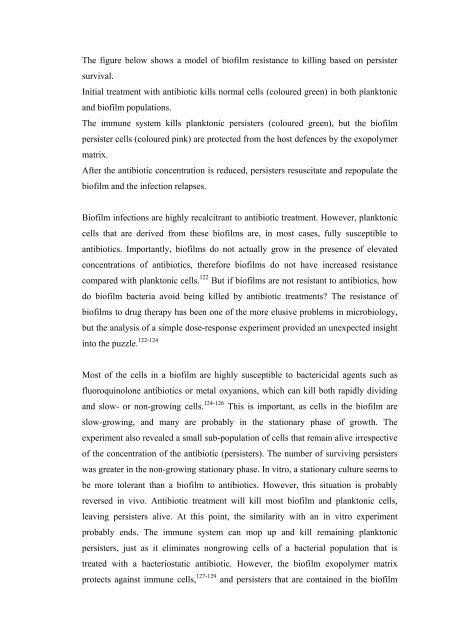Download (8Mb) - Etheses - Saurashtra University
Download (8Mb) - Etheses - Saurashtra University
Download (8Mb) - Etheses - Saurashtra University
Create successful ePaper yourself
Turn your PDF publications into a flip-book with our unique Google optimized e-Paper software.
The figure below shows a model of biofilm resistance to killing based on persister<br />
survival.<br />
Initial treatment with antibiotic kills normal cells (coloured green) in both planktonic<br />
and biofilm populations.<br />
The immune system kills planktonic persisters (coloured green), but the biofilm<br />
persister cells (coloured pink) are protected from the host defences by the exopolymer<br />
matrix.<br />
After the antibiotic concentration is reduced, persisters resuscitate and repopulate the<br />
biofilm and the infection relapses.<br />
Biofilm infections are highly recalcitrant to antibiotic treatment. However, planktonic<br />
cells that are derived from these biofilms are, in most cases, fully susceptible to<br />
antibiotics. Importantly, biofilms do not actually grow in the presence of elevated<br />
concentrations of antibiotics, therefore biofilms do not have increased resistance<br />
compared with planktonic cells. 122 But if biofilms are not resistant to antibiotics, how<br />
do biofilm bacteria avoid being killed by antibiotic treatments? The resistance of<br />
biofilms to drug therapy has been one of the more elusive problems in microbiology,<br />
but the analysis of a simple dose-response experiment provided an unexpected insight<br />
into the puzzle. 122-124<br />
Most of the cells in a biofilm are highly susceptible to bactericidal agents such as<br />
fluoroquinolone antibiotics or metal oxyanions, which can kill both rapidly dividing<br />
and slow- or non-growing cells. 124-126 This is important, as cells in the biofilm are<br />
slow-growing, and many are probably in the stationary phase of growth. The<br />
experiment also revealed a small sub-population of cells that remain alive irrespective<br />
of the concentration of the antibiotic (persisters). The number of surviving persisters<br />
was greater in the non-growing stationary phase. In vitro, a stationary culture seems to<br />
be more tolerant than a biofilm to antibiotics. However, this situation is probably<br />
reversed in vivo. Antibiotic treatment will kill most biofilm and planktonic cells,<br />
leaving persisters alive. At this point, the similarity with an in vitro experiment<br />
probably ends. The immune system can mop up and kill remaining planktonic<br />
persisters, just as it eliminates nongrowing cells of a bacterial population that is<br />
treated with a bacteriostatic antibiotic. However, the biofilm exopolymer matrix<br />
protects against immune cells, 127-129 and persisters that are contained in the biofilm

















